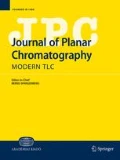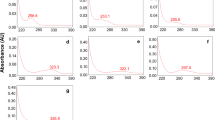Abstract
Herbal medicine is gaining its popularity day by day and gradually streaming toward integration into the mainstream healthcare systems. Therefore, standardization of herbal formulations is essential in order to assess quality of the drugs. Two commonly used paradigms, compound and pattern-based approaches, were performed to ensure quality and hence product consistency. A rapid, sensitive, and reproducible high-performance thin-layer chromatography (HPTLC) method has been developed for one of the major bioactive markers, piperine. The plates were developed using the mobile phase with toluene–ethyl acetate–formic acid–methanol (3:3:0.8:0.2, v/v). The method was validated for limit of detection, limit of quantification, linearity, specificity, precession, and recovery. The results indicate that the bioactive compound was present in 2.64% w/w in the fruit of Piper nigrum Linn. and 0.253% in a herbal formulation. Each ingredient was analyzed vis-a-vis the herbal formulation and the reflectance spectrum of the matching component(s) to ensure the presence of each ingredient in the herbal formulation. The individual component adding up has also resulted similar fingerprint pattern as that of herbal formulation. Thus, the TLC method could be a rapid tool for the delineation of each individual ingredient in the finished products for authenticity, efficacy, and for batch-to-batch consistency.















Similar content being viewed by others
References
Haldar S, Mohapatra S, Singh R, Katiyar CK (2018) Quantitative evaluation of Shatavarin IV by HPTLC. J Planar Chromatogr‒Mod TLC 31(3):197–201
Bent S (2008) Herbal medicine in the United States: review of efficacy, safety, and regulation. J Gen Intern Med 23(6):854–859
Spinella M (2002) The importance of pharmacological synergy in psychoactive herbal medicines. Altern Med Rev 7:130–137
Maciocia G (1989) The foundations of Chinese medicine: a comprehensive text for acupuncturists and herbalists. Churchill Livingstone, London
Byard RW (2010) A review of the potential forensic significance of traditional herbal medicines. J Forensic Sci 55:89–92
Bauer R (1998) Quality criteria and standardization of phytopharmaceuticals: can acceptable drug standard can be achieved. Drug Inf J 32:101–110
WHO guidelines (2017) for selecting marker substances of herbal origin for quality control of herbal medicines. WHO Technical Report Series, No. 1003:72
Hennell JR (2012) Quality control methods for herbal medicine: a multifaceted approach, XXV. University of Western Sydney
Acknowledgments
The authors wish to thank to the management, Emami Limited, Kolkata, India, for their support and constant encouragement.
Author information
Authors and Affiliations
Corresponding author
Ethics declarations
Conflict of interest
The authors declare that they have no conflict of interest.
Rights and permissions
About this article
Cite this article
Ganguly, P., Chowdhury, S., Paul, N. et al. Role of TLC to ensure manifestation of individual ingredients in herbal formulation. JPC-J Planar Chromat 33, 281–291 (2020). https://doi.org/10.1007/s00764-020-00025-0
Received:
Accepted:
Published:
Issue Date:
DOI: https://doi.org/10.1007/s00764-020-00025-0




